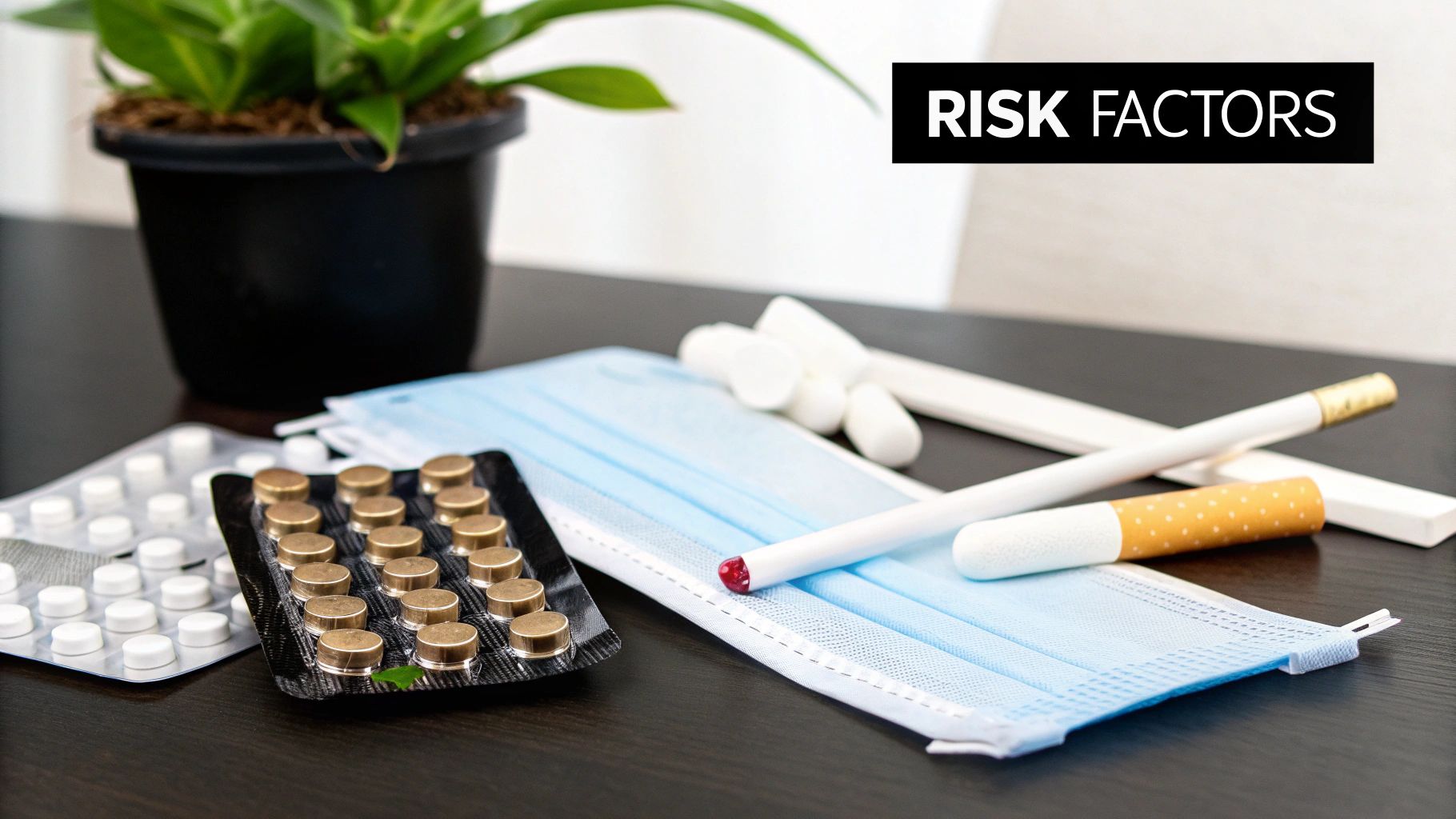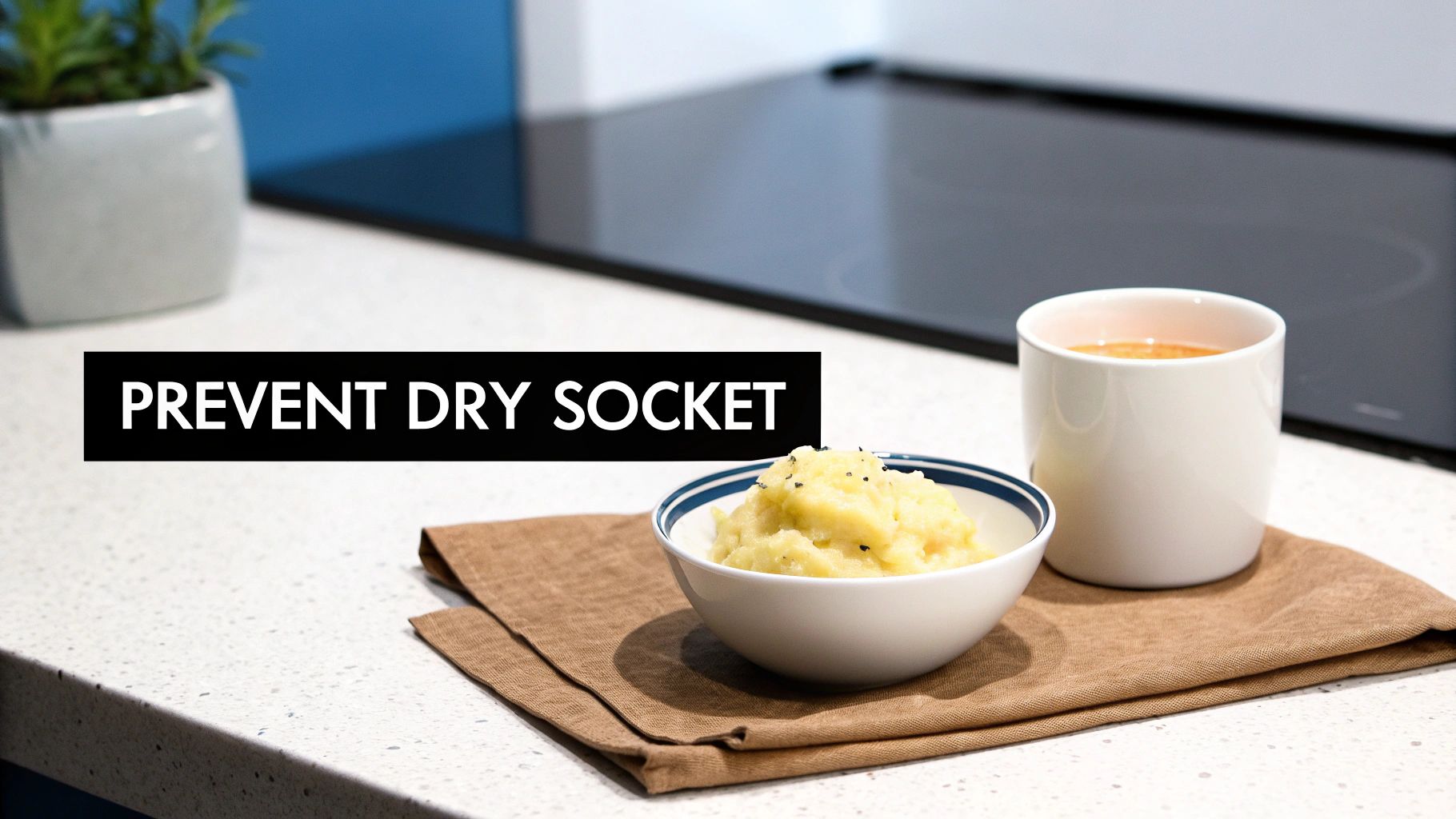What Are the Signs of a Dry Socket?
- Caterina Rutter
- Oct 25
- 8 min read
When you have a tooth pulled, the last thing you want is a painful complication. One of the most common—and dreaded—is the dry socket.
The tell-tale sign is a deep, throbbing pain that starts a few days after your procedure, right when you should be feeling better. This isn't normal post-extraction soreness; it's a much more intense pain that standard painkillers often can't touch. You might also notice a nasty taste, persistent bad breath, and if you look, you may see visible bone where a dark blood clot should be.
What Is a Dry Socket and How Does It Happen?
After an extraction, your body immediately starts healing by forming a blood clot in the empty tooth socket. This clot is a natural, protective bandage. It covers the exposed jawbone and sensitive nerve endings, shielding them from air, food, and bacteria while new tissue grows.
A dry socket, known as alveolar osteitis, happens when that protective blood clot is dislodged, dissolves too soon, or never forms correctly.
When that protective barrier is gone, the underlying bone and nerves are exposed to your mouth. This exposure is what triggers the intense, radiating pain. It can travel from the socket up to your ear or eye on the same side of your face.
How Often Does This Actually Happen?
The good news is that dry sockets are rare. While painful, they only affect a small percentage of tooth extractions.
Statistics show this complication occurs in about 0.5% to 5.6% of routine extractions. One detailed study of over 3,400 extractions found the overall rate was just 1.13%. You can read more about the prevalence of dry socket and its associated factors.
While it's a serious pain if you experience it, most people heal without any issues. The key is to know what to look for and understand the risk factors.
To make it even clearer, let's break down the key differences between a normal recovery and the warning signs of a dry socket. This side-by-side comparison can help you quickly spot if something isn't right.
Normal Healing vs. Dry Socket Quick Comparison
Symptom | Normal Healing Process | Potential Dry Socket Sign |
|---|---|---|
Pain Level | Mild to moderate discomfort that steadily improves each day. | Severe, throbbing pain that starts 2-4 days after the extraction and gets worse. |
Pain Location | Localized to the extraction site. | Pain often radiates to the ear, eye, or neck on the same side. |
Socket Appearance | A dark blood clot is visible inside the socket for the first few days. | The socket looks empty, and you may see the whitish jawbone. |
Taste/Smell | No unusual taste or smell. | An unpleasant taste in the mouth and persistent bad breath (halitosis). |
Pain Medication | Over-the-counter or prescribed pain relievers are effective. | Pain medication provides little to no relief. |
Recognizing these distinctions is your most actionable tool. If your symptoms match the "Potential Dry Socket Sign" column, it's a clear signal to call your dentist or oral surgeon immediately.
Identifying the Telltale Signs of a Dry Socket
Catching a dry socket early is the fastest way to get relief. While some discomfort after a tooth extraction is expected, the pain from a dry socket is distinct and intensifies right when you should be improving.
The number one giveaway is a severe, throbbing pain that usually begins two to four days after your procedure. This isn't the dull ache of a normal recovery. It’s an intense pain that can feel like it’s radiating from the empty socket toward your ear, eye, or temple.
The Most Common Symptoms
Beyond that signature pain, there are other clear clues that the protective blood clot is gone. Knowing what to look for helps you decide when to call your dentist.
Here are the key signs to watch for:
Visible Bone: If you look at the extraction site, you might see a whitish, bony surface instead of the dark blood clot that should be there. The socket can look disturbingly empty.
Unpleasant Taste and Odor: A persistent foul taste or bad breath (halitosis) that brushing doesn't fix is a major red flag. This is caused by food and bacteria getting trapped in the exposed socket.
Pain Unresponsive to Medication: If your prescribed or over-the-counter pain relievers aren't working, that's a sign you're dealing with more than typical post-op soreness.
The infographic below shows the two different paths your healing can take after an extraction—one smooth, and the other leading to a dry socket.

As you can see, that blood clot is the hero. Its absence separates a normal recovery from a painful complication.
Statistical Insights on Symptoms
Research backs up what dentists see in their clinics. One study following hundreds of patients found that dry sockets occurred in 15.7% of people within the first week after surgery, highlighting the importance of recognizing these signs early. You can read more about these postoperative complication findings for a deeper dive.
Your actionable takeaway: Pain that gets worse a few days after your tooth extraction isn't normal. If you have severe, radiating pain, especially with a bad taste or visible bone, you have the classic signs of a dry socket and need to contact your dentist.
Understanding the Causes and Key Risk Factors
A dry socket happens when the protective blood clot is dislodged, dissolves too early, or fails to form. Without it, the underlying bone and nerves are left painfully exposed.
What can dislodge this crucial clot? The most common culprits create suction in your mouth. Smoking and drinking through a straw are the top offenders. Even vigorous rinsing, spitting, or a forceful cough can create enough pressure to dislodge the clot.

Factors That Increase Your Risk
While physically dislodging the clot is a primary cause, some people are more prone to developing a dry socket. Knowing if you fall into a higher-risk category allows you to be extra cautious during recovery.
Here are the factors that can increase your odds:
Difficult Extractions: A complex extraction, like an impacted wisdom tooth, can cause more trauma to the area, making it harder for a stable clot to form.
Poor Oral Hygiene: Bacteria in a non-clean mouth can get into the socket and break down the blood clot. Learn how routines affect your dental health in our guide on [bad habits that could harm your teeth](https://www.zdentist.com/post/bad-habits-that-could-harm-your-teeth).
Hormonal Factors: Certain medications, especially oral contraceptives, can sometimes interfere with the body's natural ability to form a solid clot.
Your actionable takeaway: Your actions in the first few days after surgery matter most. The single best thing you can do to protect the socket is to avoid creating any negative pressure or suction in your mouth.
Research provides clear numbers. Smokers face a dry socket incidence rate as high as 6.1%, a significant jump from the 1.9% rate in non-smokers. Your age and the specific tooth also play a role; people in their late teens to early 30s having wisdom teeth removed are the most susceptible. By being aware of these predisposing factors on PMC, you can take the right steps to ensure a smooth recovery.
Actionable Steps to Prevent a Dry Socket
The best way to handle a dry socket is to prevent it from happening. Your recovery hinges on one simple goal: protecting the blood clot in the empty tooth socket. That clot is the natural band-aid your body creates to protect the bone and nerves.

From the moment you leave the dentist's office, your actions are critical. Be most careful during the first 24-48 hours—this is when the clot is most fragile.
Protecting the Extraction Site
Your main mission is to avoid creating suction or pressure inside your mouth. This is the biggest threat to the blood clot and the most common cause of a dry socket.
Here is your prevention checklist:
No Straws or Smoking: The sucking motion from using a straw or smoking can easily pull the clot out of its socket. You must avoid these for at least 72 hours, though longer is better.
Eat Soft Foods: Stick to yogurt, smoothies, applesauce, and mashed potatoes for the first few days. Avoid hard, crunchy, or sticky foods, as well as small items like seeds or rice that could get lodged in the wound.
Rinse and Spit Gently: Do not spit forcefully or swish liquids vigorously. For the first 24 hours, avoid rinsing altogether. After that, let warm salt water gently flow over the area and then let it fall out of your mouth into the sink.
Your actionable takeaway: Be gentle with your mouth. Your body is working hard to heal, and your job is to create a peaceful environment for it to do its job.
Maintaining Oral Hygiene Safely
You still need to keep your mouth clean, but it requires a careful approach. You can resume brushing your other teeth the day after your procedure, but be extremely cautious near the extraction site.
Avoid using an electric toothbrush near the area for a few days. Always follow the specific aftercare instructions your dentist provides. For a detailed recovery plan, especially after wisdom tooth removal, these [7 actionable wisdom teeth removal recovery tips for 2025](https://www.zdentist.com/post/7-actionable-wisdom-teeth-removal-recovery-tips-for-2025) are a fantastic resource. A few simple, mindful actions are all it takes to protect yourself from a painful dry socket.
When to Call Your Dentist and What Treatment Involves
Minor discomfort after a tooth extraction is normal, but if the pain increases instead of decreasing, that's your cue to seek professional help. The third day after your procedure is often a key indicator. If your pain is getting worse, not better, call your dentist. Don't try to "tough it out"—prompt treatment is the fastest path to relief.
Other red flags are a visible, empty socket or a foul taste or smell that won't go away. These are textbook signs of a dry socket that require a dentist's care. For more details on what to do next, you can check out our guide on [what to do if you have dry socket](https://www.zdentist.com/post/what-to-do-if-i-have-dry-socket-an-actionable-guide).
What to Expect During Treatment
Treating a dry socket is a straightforward process that provides almost instant relief. The goal is to clean the area and place a new protective barrier over the exposed bone and nerve.
Here’s what your dentist will do:
Clean the Socket: They will gently flush out the socket with a sterile solution to remove trapped food and debris that are causing irritation.
Place a Medicated Dressing: The dentist will then pack the clean socket with a special medicated dressing. This is often a paste with soothing ingredients like eugenol (from clove oil) to calm the hypersensitive nerves.
Your actionable takeaway: The medicated dressing acts as a temporary replacement for the lost blood clot. It shields the sensitive area, immediately reduces pain, and gives your body a clean environment to restart the healing process.
Most people feel significant improvement shortly after the dressing is placed. Your dentist will also provide simple instructions for at-home care, like gentle warm saltwater rinses, to keep the area clean as it finally heals.
Your Dry Socket Questions, Answered
It's normal to have questions during your recovery. Getting clear answers can help you feel at ease. Here are a few of the most common questions patients ask about dry socket.
How Long Does Dry Socket Pain Last?
Once a dry socket is treated by a dentist, relief is typically very fast. The medicated dressing calms the exposed nerve almost immediately.
While the intense, throbbing pain should decrease within a few hours of treatment, the site still needs to heal. You can expect the remaining, milder discomfort to gradually disappear over the next 7 to 10 days as your body's healing process gets back on track.
Can a Dry Socket Heal Without a Dentist?
Technically, a dry socket will eventually heal on its own as new tissue slowly grows over the exposed bone.
However, you should not wait for this to happen. The process would be extremely painful and take much longer than necessary. More importantly, leaving it untreated increases your risk of infection.
Your actionable takeaway: A trip to the dentist is essential. Treatment isn't just about managing pain; it's about ensuring the socket heals correctly and protecting you from further complications.
Is a Bad Smell Always a Sign of Dry Socket?
A foul odor or bad taste is a classic sign of dry socket, but it's not a standalone symptom. Sometimes, a smell can come from a simple infection or trapped food particles.
The true indicator is when the bad smell is accompanied by severe, radiating pain that gets worse a few days after your surgery. Pain is the number one sign of a dry socket. If you have both—intense pain and a persistent foul odor—call your dentist immediately.
At Beautiful Dentistry, your comfort and a smooth recovery are our top priorities. If you're dealing with severe pain or just feel like something isn't right with your healing, please don't wait and wonder. Schedule a visit with our compassionate team by visiting us at https://zdentist.com to get the relief you deserve.


Comments